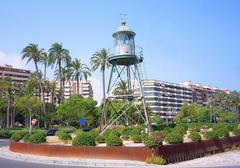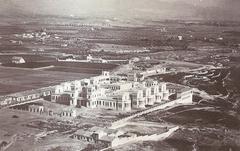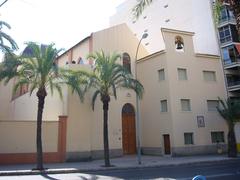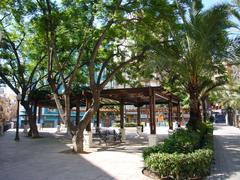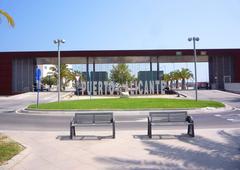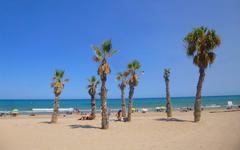Torre Villa García Visiting Hours, Tickets, and Travel Guide: Alicante Historical Sites
Date: 14/06/2025
Introduction to Torre Villa García: Alicante’s Rural Heritage Gem
Torre Villa García—also known as Torre Villagarcía or Torre Boecio—is a striking symbol of Alicante’s layered history. Nestled in the fertile Huerta de Alicante, this 16th- to 17th-century defensive tower provides a rare window into the region’s Mediterranean rural life, agricultural wealth, and coastal defense strategies. Part of the renowned “Torres de la Huerta” network, Torre Villa García was built during a period of frequent Barbary corsair raids and stands today as a testament to the ingenuity, resilience, and aspirations of Alicante’s landowning elite (guiacastillosalicante; Urbipedia).
Despite its status as a privately owned property, the tower remains highly accessible to visitors through walking trails, interpretive resources, and heritage routes. This guide provides all the essential information for planning your visit: Torre Villa García visiting hours, ticket details, accessibility, travel tips, and insights into the tower’s architectural features and cultural significance.
Historical Background of Torre Villa García
Defensive Origins and Historical Context
Torre Villa García was constructed in the 16th or early 17th century, a time when the Huerta de Alicante’s prosperity made it a target for pirate incursions. The tower formed part of a coordinated network of defensive structures—fortified farmhouses, watchtowers, and small castles—commissioned by wealthy landowners to protect family estates and agricultural workers (guiacastillosalicante).
Architectural Significance
The tower features a truncated pyramid shape and robust ashlar masonry, with a square base of approximately five meters per side. Its design prioritized defense: small, narrow windows allowed surveillance and gunfire, while a flat roof served as a lookout. A rare wooden spiral staircase connects four compact floors, and a marble coat of arms on the south facade hints at both function and prestige. Over centuries, the tower transitioned from a free-standing defense post to an integrated part of a rural estate, reflecting shifting social and economic realities.
Role in Local Heritage
Today, Torre Villa García embodies Alicante’s agricultural and defensive heritage. It is recognized as a “Bien de Interés Cultural” (BIC), Spain’s highest heritage protection status, and is a key point along heritage routes that bring visitors closer to the region’s complex history (Alicante Plaza).
Visiting Torre Villa García: Practical Information
Visiting Hours
- Exterior Viewing: The tower is privately owned; interior access is generally not available. The exterior can be viewed year-round from adjacent public roads and walking trails.
- Special Tours: On rare occasions, local heritage organizations arrange guided tours or open days. Check Alicante Turismo or contact the local tourism office for event schedules.
Tickets and Entrance Fees
- Exterior Viewing: No admission fee or tickets required to view the tower from public areas.
- Guided Tours: When available, guided tours may require advance booking and a nominal fee.
Accessibility
- The exterior is accessible, though the terrain may be uneven. There are no dedicated facilities for visitors with reduced mobility.
- Public transport, including Alicante TRAM Line 4 and local bus routes, provides convenient access to the area.
Getting There
- By Car: Ample parking on nearby streets, though spaces may be limited during peak periods.
- By Public Transport: Alicante TRAM (Line 4) and local buses serve the Playa de San Juan district.
- By Bicycle/On Foot: Combine your visit with the scenic Torres de la Huerta cycling or walking trails.
Travel Tips
- Best Time to Visit: Spring (March–May) and autumn (September–November) offer mild weather and fewer crowds.
- What to Bring: Comfortable walking shoes, sun protection, water, and a camera.
- Nearby Amenities: Cafés, restaurants, and shops are available in Playa de San Juan. Combine your visit with the beach or other towers in the network.
Architectural and Cultural Highlights
Layout and Defensive Features
- Base and Structure: Square base, truncated pyramid silhouette for stability.
- Materials: Ashlar masonry with prominent cornerstones and a classicist cornice on the terrace.
- Floors: Four levels, connected by a wooden spiral staircase.
- Windows: Small, defensive openings; later modifications enlarged some for residential use.
- Decorative Elements: Minimal, with a 17th-century marble coat of arms representing the original owners.
Integration into the Huerta
Torre Villa García is now part of a larger estate, reflecting its evolution from a defensive outpost to a symbol of agricultural prestige. Its preservation is vital to understanding Alicante’s rural history and the response to external threats.
The Torres de la Huerta Network
Torre Villa García is one of approximately 20 surviving towers from an original network of around 30, each built to protect the Huerta de Alicante. These towers are unique in Spain, blending residential, agricultural, and defensive functions. Following the reconquest, they helped secure the region’s prosperity and are now central to Alicante’s cultural tourism (Urbipedia).
Other notable towers on the route include Torre Juana, Torre Bonanza, Torre Ferrer, and Torre Sarrió. Exploring these structures offers rich insight into the socio-economic and architectural history of the area.
Planning Your Visit: Practical Tips
- Combine Sites: Plan a route that includes other Torres de la Huerta, the Castle of Santa Bárbara, and central Alicante’s historical attractions.
- Photography: Best lighting is at sunrise or sunset. Respect private property and take photos from public spaces.
- Guided Heritage Walks: Enhance your visit through guided or self-guided routes that provide historical context and interpretive signage (LinkAlicante).
- Cultural Events: Look out for local festivals, such as Hogueras de San Juan and Moors and Christians, for a deeper immersion into Alicante’s traditions (Mar Alicante).
Sustainable Tourism and Conservation
- Respect the Site: Do not attempt to enter or climb the tower; help preserve its integrity for future generations.
- Support Local Businesses: Use local cafés, guides, and shops to contribute to the community.
- Eco-Friendly Travel: Walk, cycle, or use public transport to reduce your impact (Mar Alicante).
Frequently Asked Questions (FAQ)
Q: Can I visit inside Torre Villa García?
A: The tower is privately owned and not open for interior visits. The exterior can be viewed from public roads and trails.
Q: Is there an entrance fee?
A: No. Exterior viewing is free; guided tours may have a fee.
Q: How do I get there?
A: By car (parking nearby), public transport (TRAM Line 4, local buses), or bicycle/walking along heritage trails.
Q: Is the site accessible?
A: The exterior is accessible, but the terrain may be uneven and not suitable for all visitors.
Q: Are guided tours available in English?
A: Yes, through the Alicante tourism office or local agencies.
Contact and Further Assistance
For updated information on access, tours, and events:
- Phone: (+34) 965 177 201
- Email: [email protected]
- Official website: Alicante Turismo
Visitor centers in Alicante provide maps, brochures, and personalized recommendations.
Summary and Visitor Recommendations
Torre Villa García is a must-see for those interested in Alicante’s rural history, architecture, and defensive heritage. While the interior is not generally accessible, the tower’s exterior, set within the tranquil and historic Huerta de Alicante, provides a vivid connection to the past. Enhance your visit by exploring other Torres de la Huerta, participating in guided tours, and experiencing local cultural events. For current visiting hours, tickets, and event details, consult official tourism resources and consider using digital guides or apps for a more immersive experience.

